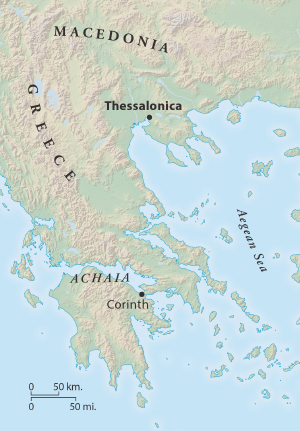
City of Thessalonica
There are four unique features of the city of Thessalonica that are important for understanding Paul’s letters to this place:
1. A Strategic Location. Thessalonica enjoys the best natural harbor in the Aegean Sea. The city was located at a juncture of the Via Egnatia (a major east-west Roman highway) and a road north to the Danube. These two geographic features caused Thessalonica to become the most populous (100,000 people) and important (provincial capital) city in Macedonia.
2. A Favored Status. As a reward for siding with the victorious Octavian in the Roman civil wars, Thessalonica was granted the designation “free city.” This favored status resulted in more autonomy over local matters, the right to mint its own coins, tax concessions, and freedom from military occupation.
3. A Unique Political Structure. As a free city, Thessalonica was allowed to keep its traditional city institutions. The lowest level involved the “citizen assembly” (“crowd” in Acts 17:5), and the highest level involved the city council, made up of unique officers called “politarchs” (“city officials” in Acts 17:6, 8).
4. A Religiously Pluralistic Setting. Archaeological and inscriptional evidence indicates the presence of various Greco-Roman deities, such as Dionysus, Asclepius, Aphrodite, Demeter, and Zeus. The Egyptian gods Isis and Serapis were also popular, as was the imperial cult with its worship of the Roman Empire. The city also housed a large Jewish synagogue consisting of “a large number of God-fearing Greeks and quite a few prominent women” (Acts 17:4). Most of the Thessalonian church had participated in these various cults before they “turned to God from idols” (1 Thess 1:9).
Paul and the Thessalonian Church
Paul’s two letters to the Thessalonians should be read in light of the various events connected with the apostle’s ministry to these believers:
1. Paul, along with Silas and Timothy, departed from Philippi, traveled 90 miles (145 kilometers) along the Via Egnatia, and arrived four or five days later in Thessalonica (2:1–2; Acts 17:1).
2. Paul preached for three Sabbaths in the synagogue; converts included some Jews and even more Gentiles, including women from leading families (Acts 17:2–4).
3. During the week, Paul supported himself by working as a tentmaker (Acts 18:3), thereby not only providing the new Christians with an example of self-sufficient work (1 Thess 2:9; 2 Thess 3:7–10) but avoiding potential charges that his ministry was selfishly motivated (1 Thess 2:1–12).
4. Paul’s missionary success aroused opposition. The Jews acted first (they “drove us out,” 2:15) and with the help of “bad characters from the marketplace” started a city riot against the apostle, accusing him of disturbing the peace and violating Caesar’s decrees (Acts 17:5–8).
5. Paul, Silas, and Timothy left Thessalonica to protect the believers and traveled west for two days to Berea (Acts 17:10). But Jews from Thessalonica followed the apostle to Berea and forced him to leave town. Some believers escorted Paul to Athens, likely by sea.
6. Silas and Timothy joined Paul in Athens a short time later only to be sent back to Macedonia: Timothy to Thessalonica (3:1–5) and Silas possibly to Philippi. Paul tried but was prevented from revisiting Thessalonica (2:17–18).
7. Paul traveled from Athens to begin an 18-month ministry in Corinth, where Timothy and Silas rejoined him from Macedonia (Acts 18:5). Timothy gave Paul a largely positive report about the Thessalonian church (1 Thess 3:6–10) but shared four concerns (see Introdution: Purposes) that caused the apostle to write 1 Thessalonians from Corinth in AD 50–51.
8. A short time later Paul received an alarming report from Thessalonica concerning a false claim that “the day of the Lord has already come” (2 Thess 2:2) and informing him that the problem of idle believers had become worse (2 Thess 3:6–15). To respond to these two problems, Paul wrote 2 Thessalonians.
Author, Date, and Place of Writing
Although Silas and Timothy are listed as co-senders, Paul is the letter’s primary author (note the use of the singular “I” in 2:18; 3:5; 5:27). Pauline authorship is supported by both internal and external evidence: the letter exhibits features typical of the apostle’s writing style, and the early church writers all affirm Paul as the author, with testimonies beginning as early as AD 140 (Marcion). The apostle wrote the letter in AD 50–51 during his 18-month ministry in Corinth. Support for this date comes from the Delphic Inscription, a letter from Emperor Claudius found in Delphi that dates Gallio’s governorship of Achaia to AD 51–52 and thus places Paul in Corinth at the same time (see note on Acts 18:12–17). Except for the possibility of an early date for Galatians (AD 48), 1 Thessalonians is Paul’s earliest canonical letter.
Purposes
After Paul sent Timothy back to Thessalonica (3:1–5), Timothy returned to the apostle with a largely positive report about the Thessalonian church (3:6). Yet Timothy also informed Paul about four concerns that caused the apostle to write 1 Thessalonians:
1. Paul’s Integrity. Non-Christians in Thessalonica accused Paul of impure, selfish motives, causing the apostle in the first half of the letter to defend his ministry and that of his co-workers, Silas and Timothy (2:1—3:10).
2. Persecution. Paul encourages his readers who were being persecuted for their new faith (2:14; 3:1–5).
3. Proper Moral Conduct. Paul exhorts his readers to live a holy life (4:1–12; 5:12–22).
4. Christ’s Return. Paul comforts his readers about the fate of both deceased (4:13–18) and living (5:1–11) believers at Christ’s return.
Outline
I. Opening (1:1)
II. Thanksgiving for the Thessalonians’ Faith (1:2–10)
III. Defense of Past Ministry and Present Absence (2:1—3:10)
A. Defense of Past Ministry in Thessalonica (2:1–16)
B. Defense of Present Absence From Thessalonica (2:17—3:10)
IV. Transitional Prayers (3:11–13)
V. Exhortations to the Thessalonians (4:1—5:22)
A. Pleasing God in Sexual Conduct and Love for Others (4:1–12)
B. Comfort Concerning Deceased Christians at Christ’s Return (4:13–18)
C. Comfort Concerning Living Christians at Christ’s Return (5:1–11)
D. Exhortations on Congregational Life and Worship (5:12–22)
VI. Closing (5:23–28)
![]()
![]()
![]()

